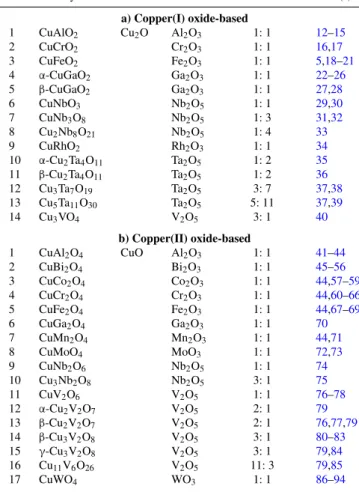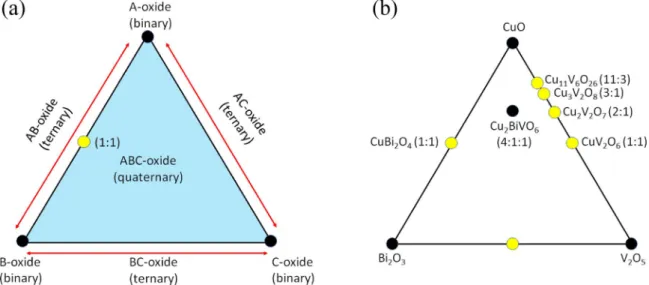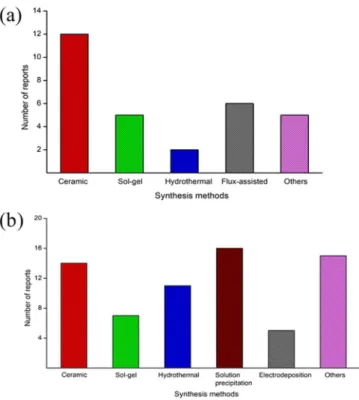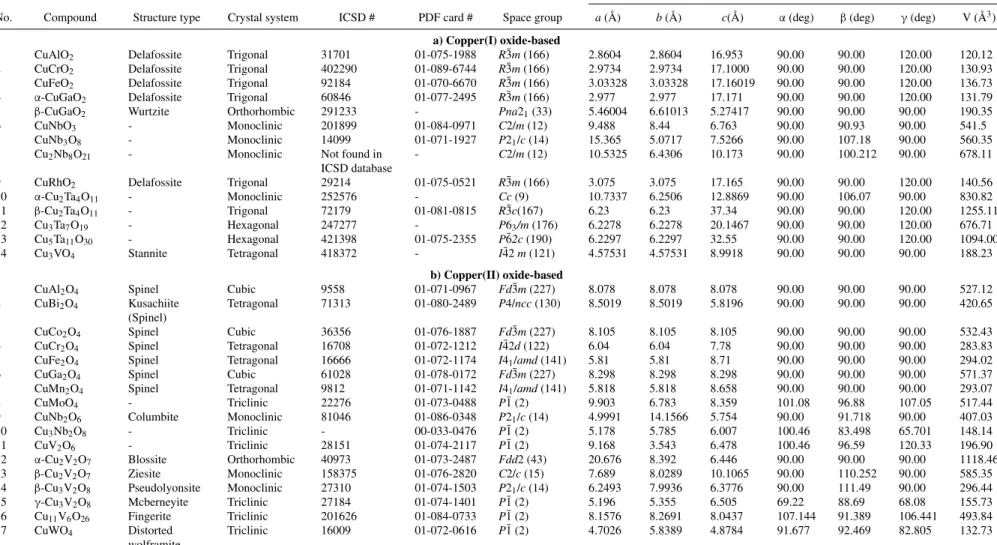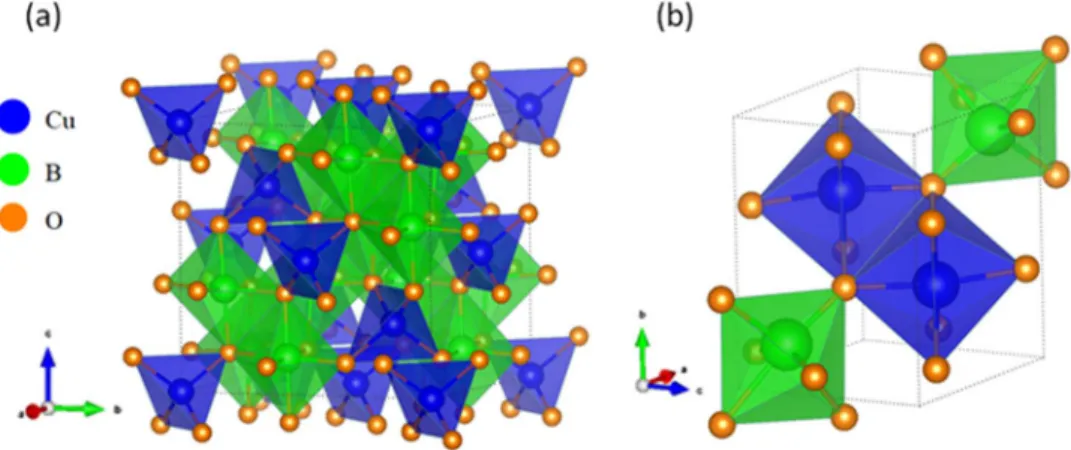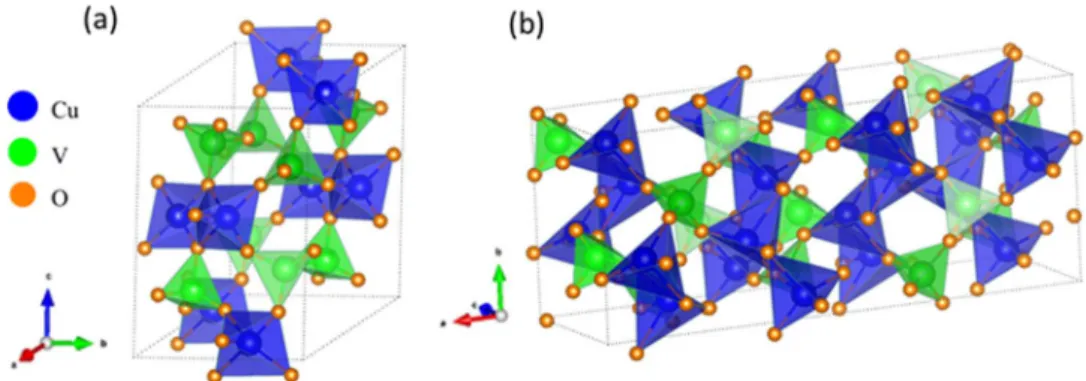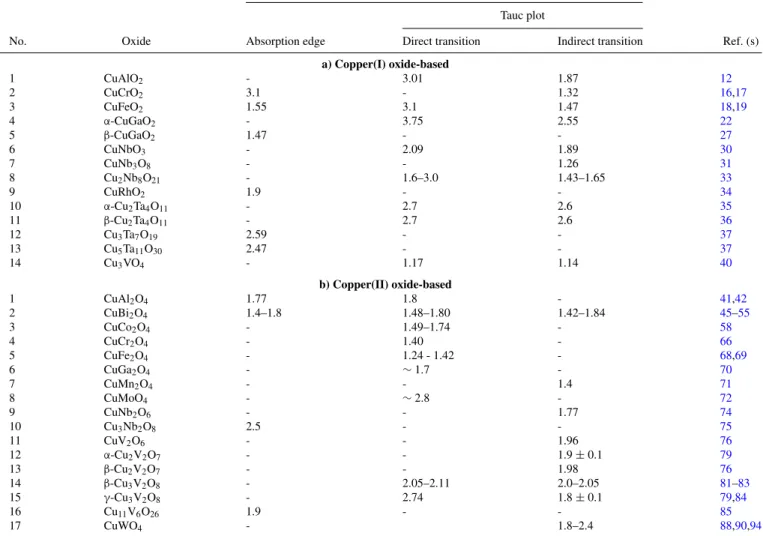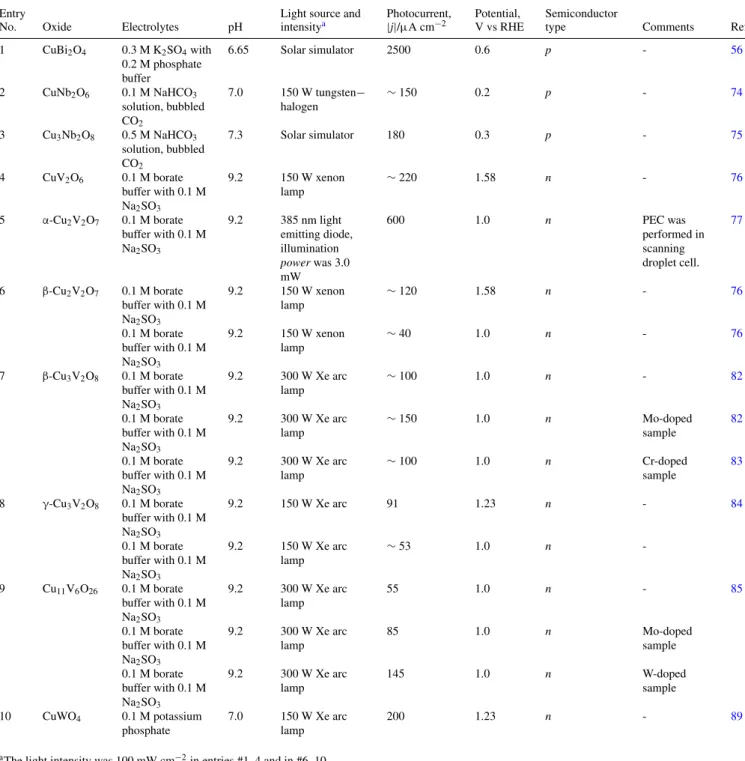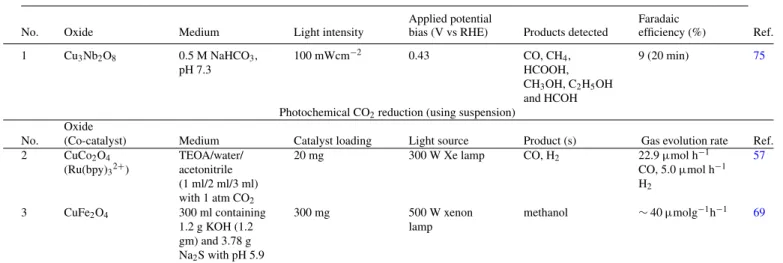H3192 Journal of The Electrochemical Society,165(4) H3192-H3206 (2018)
JES F
OCUSI
SSUE ONP
ROCESSES AT THES
EMICONDUCTOR-S
OLUTIONI
NTERFACEReview—Copper Oxide-Based Ternary and Quaternary Oxides:
Where Solid-State Chemistry Meets Photoelectrochemistry
Krishnan Rajeshwar, 1,∗,zMohammad Kabir Hossain,1,∗∗Robin T. Macaluso,1 Csaba Jan´aky,2,3Andras Varga,2,3and Pawel J. Kulesza4,∗∗∗
1Department of Chemistry & Biochemistry, The University of Texas at Arlington, Arlington, Texas 76109-0065, USA
2MTA-SZTE, Lend¨ulet Photoelectrochemistry Research Group, Szeged H-6720, Hungary
3Department of Physical Chemistry and Materials Science, University of Szeged, Szeged H-6720, Hungary
4Faculty of Chemistry, University of Warsaw, PL-02-093 Warsaw, Poland
This review article addresses areas where solid-state chemistry concepts can contribute to the on-going search for a “magic bullet”
inorganic semiconductor that can efficiently split water or reduce CO2. First, a methodology to visualize complex ternary oxide combinations is outlined using 31 examples based on copper in both+1 and+2 oxidation states. Then the synthetic aspects are reviewed followed by a discussion of the structural characteristics. The optoelectronic aspects are considered next, culminating the review with the state-of-the-art in the practical applicability of these materials in solar fuels photogeneration and environmental (e.g., azo dye) remediation.
© The Author(s) 2018. Published by ECS. This is an open access article distributed under the terms of the Creative Commons Attribution 4.0 License (CC BY,http://creativecommons.org/licenses/by/4.0/), which permits unrestricted reuse of the work in any medium, provided the original work is properly cited. [DOI:10.1149/2.0271804jes]
Manuscript submitted January 15, 2018; revised manuscript received March 6, 2018. Published March 24, 2018.This paper is part of the JES Focus Issue on Processes at the Semiconductor-Solution Interface.
This review article addresses the nexus between two seemingly disparate disciplines, namely solid-state chemistry (SSC) and pho- toelectrochemistry (PEC) using copper-based complex (ternary and quaternary) oxides as a discussion framework. The two disciplines, SSC and PEC, have more or less developed in a parallel fashion since their halcyon days in the mid-1970s. Both SSC and PEC shared an interest in similar materials (mainly oxides and chalcogenides) but for rather different applications. While SSC has focused mainly on mag- netic or electronically and ionically conductive solid materials, and eventually evolving to superconducting (so-called high Tc) materials, PEC has dealt mainly with inorganicsemiconductors. However, and interestingly enough, the two disciplines have coalesced in the area of energy conversion. The past couple decades have thus witnessed remarkable advances in the development of solid-state materials for Li-ion batteries, thermoelectric conversion, photovoltaic solar cells, and solid-oxide fuel cells. Even high Tc-superconductivity studies have translated to niche applications in practical technologies. How- ever, in spite of a comparably early history of study, solar fuels (e.g., water splitting, CO2reduction, N2reduction) have not seen the light of day in terms of commercialization.
One may well argue that we lack a “magic bullet” inorganic semi- conductor that can split water or reduce CO2in a stable, sustainable, and efficient manner because the connection between SSC and PEC has only occurred in fits and starts. With the entry of (a veritable melt- ing pot of) scientists from a wide variety of technical backgrounds (e.g., colloid chemistry, ultrafast spectroscopy, solid-state physics, electrochemistry, etc.) into the PEC field, it was only natural that the emphasis on solid statechemistryhas been somewhat diluted. For example, while the early history of PEC is liberally sprinkled with studies from solid-state research groups (see Refs.1–4as random examples), instances in the post 1990 s where SSC concepts have beenrationallyand deliberatelyapplied, are sporadic,5,6 as further discussed below.
Scope of Review and Literature Precedence
This review refocuses the key role that solid-state chemistry can play in the continuing search for an inorganic semiconductor (or
∗Electrochemical Society Fellow.
∗∗Electrochemical Society Student Member.
∗∗∗Electrochemical Society Member.
zE-mail:rajeshwar@uta.edu
a combination of semiconductors) for solar fuels photogeneration.
First, means of visualizing complex oxide chemical compositions are introduced via suitable diagrams. Next, the synthetic aspects are considered followed by a review of the structural aspects of copper oxide-based ternary and quaternary oxides starting with the parent oxides, copper(I) oxide and copper(II) oxide (Cu2O and CuO). The optoelectronic attributes are discussed in turn, culminating in an exam- ination of the extent to which these new materials have met the needs for applicability in the solar fuels and environmental remediation arenas.
We are not aware of a similar, overarching review on this topic although copper(I)-basedp-type oxides were recently reviewed for photoelectrochemical and photovoltaic solar energy conversion applications.6Tantalum- and niobium-based ternary oxides were dis- cussed in this particular article, as were four copper(I) delafossites and two Cu-V-O oxides (Cu3VO4 and Cu2V3O8).6Areas where the present article overlaps with this precedent review are identified later.
The synthetic aspects of ternary metal oxide nanostructures have been reviewed7 as were their applications in supercapacitors.8 While not focusing per se on solar fuels generation, three recent articles9–11 may be cited that share a similar objective to the present review:
namely, targeted materials development for a specific application.
Thus, we note a recent article that discusses how simple chemical concepts can be turned into viable strategies for thermoelectric mate- rials development.9
Another article10focuses on the accuracy of density functional the- ory in predicting the formation energetics of ternary oxides from their binary oxide counterparts. Finally, ab initio global structural predic- tion, and specifically the minima hopping method, was used to study 183 different compositions of the form, MXO2, where M=Cu, Ag, or Au (coinage metal), and X is an element in the Periodic Table.11 The application target in this particular study wasp-type transparent conducting oxide (TCO) development.11While the materials’ applica- tion focus in the present discussion is mostly on solar water splitting, closely allied technology aspects related to photoelectrochemical CO2
reduction and heterogeneous photocatalytic environmental remedia- tion are also peripherally addressed, for the sake of completeness.
It is worth noting that the photocatalysis application has seen the light of day, in terms of commercial realization, sooner than the other applications.
TablesIa andIbsummarize the oxide candidates considered in the present review article; the two compilations relate to compounds based on copper in the +1 and +2 oxidation states respectively.
) unless CC License in place (see abstract).
ecsdl.org/site/terms_use address. Redistribution subject to ECS terms of use (see
160.114.21.80 Downloaded on 2018-04-25 to IP
Table I. Copper oxide-based ternary oxides considered in this review. a) Copper(I) oxide-based. b) Copper(II) oxide-based.
No. Ternary Oxide A oxide B oxide A oxide: B oxide Ref(s).
a) Copper(I) oxide-based
1 CuAlO2 Cu2O Al2O3 1: 1 12–15
2 CuCrO2 Cr2O3 1: 1 16,17
3 CuFeO2 Fe2O3 1: 1 5,18–21
4 α-CuGaO2 Ga2O3 1: 1 22–26
5 β-CuGaO2 Ga2O3 1: 1 27,28
6 CuNbO3 Nb2O5 1: 1 29,30
7 CuNb3O8 Nb2O5 1: 3 31,32
8 Cu2Nb8O21 Nb2O5 1: 4 33
9 CuRhO2 Rh2O3 1: 1 34
10 α-Cu2Ta4O11 Ta2O5 1: 2 35
11 β-Cu2Ta4O11 Ta2O5 1: 2 36
12 Cu3Ta7O19 Ta2O5 3: 7 37,38
13 Cu5Ta11O30 Ta2O5 5: 11 37,39
14 Cu3VO4 V2O5 3: 1 40
b) Copper(II) oxide-based
1 CuAl2O4 CuO Al2O3 1: 1 41–44
2 CuBi2O4 Bi2O3 1: 1 45–56
3 CuCo2O4 Co2O3 1: 1 44,57–59
4 CuCr2O4 Cr2O3 1: 1 44,60–66
5 CuFe2O4 Fe2O3 1: 1 44,67–69
6 CuGa2O4 Ga2O3 1: 1 70
7 CuMn2O4 Mn2O3 1: 1 44,71
8 CuMoO4 MoO3 1: 1 72,73
9 CuNb2O6 Nb2O5 1: 1 74
10 Cu3Nb2O8 Nb2O5 3: 1 75
11 CuV2O6 V2O5 1: 1 76–78
12 α-Cu2V2O7 V2O5 2: 1 79
13 β-Cu2V2O7 V2O5 2: 1 76,77,79
14 β-Cu3V2O8 V2O5 3: 1 80–83
15 γ-Cu3V2O8 V2O5 3: 1 79,84
16 Cu11V6O26 V2O5 11: 3 79,85
17 CuWO4 WO3 1: 1 86–94
Figures1aand1billustrate the materials’ scope from a Periodic Table perspective.
Visualizing Ternary and Quaternary Oxide Compositions and Their Relationship to the Binary Oxide Components In this paper, A, B, and C represent metal cations in a ternary or quaternary oxide compound. Of course, for the present discussion, A=Cu in all the cases. At first glance, the various oxide compositions in TablesIaandIbappear to be complicated in terms of the combina- tions of formula subscripts, especially in the Cu-Nb-O, Cu-Ta-O, and Cu-V-O cases. However, a simple way to visualize these is to break up each ternary compound into a combination of the component binaries.
Thus the two binaries are shown in columns 3 and 4 of TablesIaand Iband their combining ratios is shown in column 5 in each case. Thus the vast majority of the compounds considered are rather simple 1:1 molar combinations, although combinations such as 11:3 are observed in the Cu-V-O systems. Polymorphs of the same compound are also observed in many cases (designated in TablesIaandIbbyα,β, etc.) and they will be further considered in the section below on structural aspects.
A final point to note is that the prescribed visualization of ternary compounds as combinations of corresponding binaries, is by no means, unique to oxides. This approach works equally well for non- oxides, e.g., chalcogenides, phosphides, arsenides etc. By extrapola- tion, quaternary compounds may be visualized as derived from the component binaries in the same manner. Thus, the quaternary com- pound, AgBiW2O8, studied by one of us recently,95is really a 1:1:4 combination of the three component oxides, namely, Ag2O, Bi2O3, and WO3. Certainly, this is not readily apparent from the above for- mula! Other Cu-based quaternary compounds are considered below.
Phase diagrams can also represent thermodynamically stable ternary and quaternary compounds based on their simpler compo- nents; this is depicted in Figure2. The generic ternary phase diagram is shown in Figure2aand a specific Cu-Bi-V-O system is considered in Figure2b. Consider Figure2afirst. Each corner of the (equilateral) triangle represents 100% of one component (i.e., a binary compound).
Points along each edge of the equilateral triangle represent a combi- nation of two binaries on either end of the triangle. Any point on the edge must follow the lever rule; for example, the mid-point constitutes the 1:1 ternary compound, and AB2Oxis represented as a point that is located 1/3 of the length toward the corner labeled “A-oxide” and 2/3 of the length toward the corner labeled “B-oxide.” For example, a point in the middle of the triangle represents an oxide with the chem- ical formula, ABCOx, where one expects 33.3% each of the A-oxide, B-oxide and C-oxide. The convex-hull formalism,10commonly used for thermodynamic predictions, logically derives from similar ideas.
The Cu-V-O phase space is particularly rich and the four known compounds (Table I) are shown in Figure 2b. The 1:1 compound between Bi2O3and V2O5, positioned at the mid-point on the bottom horizontal edge in Figure2b, is the well-studied BiVO4. While not directly relevant for this review on Cu-based oxides, this particular compound is only shown in this diagram because it is a “champion”
ternary oxide in terms of performance in solar water splitting.96 The CuO-V2O5 edge shows four stable ternary compounds that lie on the CuO-rich side of the edge, while the Bi2O3-CuO edge reveals one compound, CuBi2O4, with a 1:1 molar ratio of Bi2O3and CuO. The interior of the triangle in Figure2represents the quaternary phase space and one specific Cu-Bi-V-O compound (the 4:1:1 ratio of CuO-Bi2O3-V2O5) is depicted in Figure2b. Compositions beyond the quaternary case will necessitate the use of 3-D objects for visualization and their rarity puts them beyond the scope of the present discussion.
A final way to consider ternary compositions is to consider them as comprising of ionic fragments of the A cation (i.e., Cu+or Cu2+) and the BO cluster. Indeed the compound name, in many cases, is derived by this underlying idea. To illustrate, CuBi2O4or “copper bismuthate”
(TableIb), may be considered to be composed of Cu2+and Bi2O42−
fragments. Similarly, entries #4 and #5 in Table Ibwould read as
“copper chromate” and “copper ferrate” respectively. There are other also more well-known such examples amongstnon-Cusystems, e.g., bismuth titanates etc. Nonetheless, we favor the visualization based on component oxides instead, especially because the “ionic approach”
is difficult to apply to quaternary cases and beyond.
Synthetic Aspects
As may be expected, a wide range of synthetic methodologies have been deployed for the preparation of ternary oxides based on Cu(I) and Cu(II). Figure3captures the distribution of a random sampling of these methods in the literature focusing only PEC or photocatalysis applications. Interestingly, ceramic preparation routes account for a significant number of instances in these studies. This trend is entirely in line with the theme of this review on the close relationship between solid-state chemistry and PEC. Worthy also of note is the fact that the “catch-all” (Others) category is the dominant category of methods in the Cu(II) case. This category includes variant techniques such as ion exchange, solution combustion synthesis, spin-coating, spray- pyrolysis, or metal-organic decomposition.
Given that the set of materials attributes needed for a given technological application (e.g., solar water splitting) is rather well understood,97it would have been ideal if a given synthesis set of con- ditions could be tailored a priori to yield the material with precisely those attributes. Unfortunately, this is not the case given the present state-of-the-art. The targeted attributes may even be contradictory.
For example, solar energy conversion applications dictate the use of very large active material area to compensate for the diluteness of the incoming energy source (i.e., sunlight), unless of course concentrator strategies are employed. On the other hand, when nanoparticles of the active material are used, larger crystallite sizes (approaching single crystal behavior!) must be sought to minimize the role of defects and optimize carrier collection.
H3194 Journal of The Electrochemical Society,165(4) H3192-H3206 (2018)
Figure 1. The ternary compounds based on Cu(I) (a) and Cu(II) (b) considered in this study and their component elements with respect to the Periodic Table (see also TablesIaandIb). As in the crystal structures below, the elements are color-coded, blue being the A cation (Cu) while green is the B cation in the ternary oxide compound.
Figure 2. Graphical visualization of ternary and quaternary oxides, for the generic (a) and Bi2O3-CuO-V2O5(b) cases.
) unless CC License in place (see abstract).
ecsdl.org/site/terms_use address. Redistribution subject to ECS terms of use (see
160.114.21.80 Downloaded on 2018-04-25 to IP
Figure 3. A sampling of the literature on PEC and photocatalysis for the examples of the choice of synthesis approaches for Cu(I) (a) and Cu(II) (b) compounds respectively. Refer also to text.
It is clear that in cases where an energy-harvesting material is to be synthesized, the energy investment for the synthesis itself, must be minimized such that the energy payback time is shortened. Solid-state (i.e., ceramic) synthesis routes are handicapped in this regard be- cause they involve rather high temperatures. On the other hand, tech- niques such as solution combustion synthesis (SCS)55,94are attractive because the thermal energy required for the synthesis is contained within the heat of combustion of the fuel:oxidizer precursor mixture.
Another important advantage of SCS is the versatility it offers for tuning the range of composition of the end product simply by vary- ing the precursor ratio. Thus, an entire range of oxide compositions from neat CuO on the one side to the 1:1 ternary, CuBi2O4, and to Bi2O3on the other, could be generated using SCS.55Nanocomposites containing CuO and CuBi2O4 nanoparticles in electronic contact or the Bi2O3/CuBi2O4material could also be synthesized.55Even more significantly, SCS has also afforded the scope for preparing doped oxides or solid solutions as elaborated later in this review.
Materials discovery in its current state of evolution has to rely on either tedious trial-and error methodologies or more efficiently, the combinatorial variant. In this regard, synthesis methods that are time-efficient(such as SCS) hold a significant advantage over pro- longed techniques (spanning several hours) such as sol-gel or solid- state routes.
Structural Aspects
Oxides display a remarkable array of structural variations that could be visualized at different levels. At the outset, we can ac- commodate a particular structure within a mineral type such as per- ovskite, spinel, delafossite etc. Another approach derives from crystal- lographic examination and description of the solid-state arrangement in terms of a particular space group and unit cell dimensions. A local- ized (“inorganic chemist’s”) view considers the A-O or B-O clusters that are building blocks within the overall framework and the coordi- nation environment around the Cu cations. All three descriptions are complementary and are adopted herein, see TablesIIaandIIbfor the thirty-one compounds considered in this review.
The polyhedral representations are particularly illuminating in this regard, and we begin with the structure of the perovskite prototype—
a veritable “mother” of all structure types that are important in wide range of technological materials science applications. This is illus- trated in Figure4, with the Cu cation, the B cation, and the oxygens color coded the same way everywhere (c.f., Figure1) for easy visu- alization. Rational and deliberate structure modifications, designed, to impart a certain characteristic (for example, a lowered optical bandgap), may be conveniently discussed with reference to this struc- tural framework. Chemical alterations may be made either to the cationic sub-lattice or to the anionic framework (Figure4). Thus the B cation or the oxygens in the perovskite structure may be substi- tuted with another cation or anion with comparable ionic radii re- spectively. Nitrogen (rN=1.5 Å) readily substitutes for oxygen (rO= 1.4 Å) affording the corresponding oxynitrides, although note that the charges are not the same in the two cases. Rational andsimultaneous chemical alterations of this sort, targetingboth the sub-lattices, have been reported98for ABO2N type compounds, although such examples seem to be as yet sparse, for Cu-based oxides. Indeed, the so-called heteroanionic systems (e.g., oxynitrides, oxysulfides)99.100 have gar- nered much interest in recent years, spurred by applications in solar fuels, thermoelectrics etc. However, these mixedanioniccompounds are beyond the scope of the present review.
If two B cations are within∼15% of the size of one another, a range of solid solutions may be derived with interesting gradation in structural (e.g., unit cell dimension) or optical (energy bandgap, Eg) attributes. This behavior is exemplified by the Cu-Fe-Cr-O system (Figures 5and6); these new materials were prepared via SCS by simple compositional tuning of the precursor mixture. Note that both the lattice parameter (a, b with black and c with blue traces in Figure 5) and Egvalue (Figures6) vary, albeit not in the same manner – the change in Egwith the extent of substitution, x being much more drastic (c.f., Figures5band6b). The linear change of the lattice parameter with composition confirmed that this ternary alloy followed Vegard’s law.101
It is worth noting that literature examples of solid solutions within theternarycompound space are not as common as within thebinary compound space. Therefore, these new and interesting examples pro- vide a guiding template for future studies on chemical composition- property relationships.
Consider now the structures of the two parents: Cu2O and CuO (Figures7aand7brespectively). The unit cells are also superimposed on the ball-and-stick representation in the two cases as dotted lines.
While the Cu2O structure consists of a cubic unit cell, it is hexagonal for the CuO case. The local coordination geometry is also clearly seen to differ switching from linear in the former case to tetrahedral in the latter. Further structure details may be found for Cu2O in a preceding review article.6TableIIlists all the crystallographic attributes for the two parent structures as well as the 31 derivatives considered in this study.
Delafossites (Figure8) are an important structural type for the Cu(I) case and several of these were also considered by previous authors;6therefore, their discussion is much abbreviated here. Inter- estingly, variant local coordination environments for the two cations are seen in the structural framework: linear for Cu(I) but octahedral for the B(III) cation. This structure type is observed for CuBO2 (B
=Rh, Fe, Al) (TableIIa). By contrast, the two cations experience a similar pyramidal coordination environment in the wurtzite structure (not shown), typical of CuGaO2.
The structures of the other Cu(I) based oxides with Nb, Ta, or V as the B cation (see TableIIa) have been extensively discussed elsewhere by previous authors,6and therefore are not further considered here.
Instead, we now turn to structures based on Cu(II): two common structure types are spinels and wolframite, shown in Figures9aand 9brespectively. Copper-containing spinels with the general chemical formula, CuB2O4, have a tetragonal unit cell while Cu-containing wolframites (general formula: CuBO4) possess a unit cell of much lower symmetry: either, monoclinic or triclinic, depending on the particular compound (TableIIb). Once again, the local coordination
H3196JournalofTheElectrochemicalSociety,165(4)H3192-H3206(2018)
Table II. Structural details of copper(I)- and copper(II)-based oxides.
Cell parameters
No. Compound Structure type Crystal system ICSD # PDF card # Space group a(Å) b(Å) c(Å) α(deg) β(deg) γ(deg) V (Å3) a) Copper(I) oxide-based
1 CuAlO2 Delafossite Trigonal 31701 01-075-1988 R¯3m(166) 2.8604 2.8604 16.953 90.00 90.00 120.00 120.12
2 CuCrO2 Delafossite Trigonal 402290 01-089-6744 R¯3m(166) 2.9734 2.9734 17.1000 90.00 90.00 120.00 130.93
3 CuFeO2 Delafossite Trigonal 92184 01-070-6670 R¯3m(166) 3.03328 3.03328 17.16019 90.00 90.00 120.00 136.73
4 α-CuGaO2 Delafossite Trigonal 60846 01-077-2495 R¯3m(166) 2.977 2.977 17.171 90.00 90.00 120.00 131.79
5 β-CuGaO2 Wurtzite Orthorhombic 291233 - Pna21(33) 5.46004 6.61013 5.27417 90.00 90.00 90.00 190.35
6 CuNbO3 - Monoclinic 201899 01-084-0971 C2/m(12) 9.488 8.44 6.763 90.00 90.93 90.00 541.5
7 CuNb3O8 - Monoclinic 14099 01-071-1927 P21/c(14) 15.365 5.0717 7.5266 90.00 107.18 90.00 560.35
8 Cu2Nb8O21 - Monoclinic Not found in
ICSD database
- C2/m(12) 10.5325 6.4306 10.173 90.00 100.212 90.00 678.11
9 CuRhO2 Delafossite Trigonal 29214 01-075-0521 R¯3m(166) 3.075 3.075 17.165 90.00 90.00 120.00 140.56
10 α-Cu2Ta4O11 - Monoclinic 252576 - Cc(9) 10.7337 6.2506 12.8869 90.00 106.07 90.00 830.82
11 β-Cu2Ta4O11 - Trigonal 72179 01-081-0815 R¯3c(167) 6.23 6.23 37.34 90.00 90.00 120.00 1255.11
12 Cu3Ta7O19 - Hexagonal 247277 - P63/m(176) 6.2278 6.2278 20.1467 90.00 90.00 120.00 676.71
13 Cu5Ta11O30 - Hexagonal 421398 01-075-2355 P¯62c(190) 6.2297 6.2297 32.55 90.00 90.00 120.00 1094.00
14 Cu3VO4 Stannite Tetragonal 418372 - I¯42m(121) 4.57531 4.57531 8.9918 90.00 90.00 90.00 188.23
b) Copper(II) oxide-based
1 CuAl2O4 Spinel Cubic 9558 01-071-0967 Fd¯3m(227) 8.078 8.078 8.078 90.00 90.00 90.00 527.12
2 CuBi2O4 Kusachiite (Spinel)
Tetragonal 71313 01-080-2489 P4/ncc(130) 8.5019 8.5019 5.8196 90.00 90.00 90.00 420.65
3 CuCo2O4 Spinel Cubic 36356 01-076-1887 Fd¯3m(227) 8.105 8.105 8.105 90.00 90.00 90.00 532.43
4 CuCr2O4 Spinel Tetragonal 16708 01-072-1212 I¯42d(122) 6.04 6.04 7.78 90.00 90.00 90.00 283.83
5 CuFe2O4 Spinel Tetragonal 16666 01-072-1174 I41/amd(141) 5.81 5.81 8.71 90.00 90.00 90.00 294.02
6 CuGa2O4 Spinel Cubic 61028 01-078-0172 Fd¯3m(227) 8.298 8.298 8.298 90.00 90.00 90.00 571.37
7 CuMn2O4 Spinel Tetragonal 9812 01-071-1142 I41/amd(141) 5.818 5.818 8.658 90.00 90.00 90.00 293.07
8 CuMoO4 - Triclinic 22276 01-073-0488 P¯1 (2) 9.903 6.783 8.359 101.08 96.88 107.05 517.44
9 CuNb2O6 Columbite Monoclinic 81046 01-086-0348 P21/c(14) 4.9991 14.1566 5.754 90.00 91.718 90.00 407.03
10 Cu3Nb2O8 - Triclinic - 00-033-0476 P¯1 (2) 5.178 5.785 6.007 100.46 83.498 65.701 148.14
11 CuV2O6 - Triclinic 28151 01-074-2117 P¯1 (2) 9.168 3.543 6.478 100.46 96.59 120.33 196.90
12 α-Cu2V2O7 Blossite Orthorhombic 40973 01-073-2487 Fdd2 (43) 20.676 8.392 6.446 90.00 90.00 90.00 1118.46
13 β-Cu2V2O7 Ziesite Monoclinic 158375 01-076-2820 C2/c(15) 7.689 8.0289 10.1065 90.00 110.252 90.00 585.35
14 β-Cu3V2O8 Pseudolyonsite Monoclinic 27310 01-074-1503 P21/c(14) 6.2493 7.9936 6.3776 90.00 111.49 90.00 296.44
15 γ-Cu3V2O8 Mcberneyite Triclinic 27184 01-074-1401 P¯1 (2) 5.196 5.355 6.505 69.22 88.69 68.08 155.73
16 Cu11V6O26 Fingerite Triclinic 201626 01-084-0733 P¯1 (2) 8.1576 8.2691 8.0437 107.144 91.389 106.441 493.84
17 CuWO4 Distorted
wolframite
Triclinic 16009 01-072-0616 P¯1 (2) 4.7026 5.8389 4.8784 91.677 92.469 82.805 132.73
) unless CC License in place (see abstract). ecsdl.org/site/terms_use address. Redistribution subject to ECS terms of use (see 160.114.21.80Downloaded on 2018-04-25 to IP
Figure 4. The perovskite structure; the unit cell is shown as a dotted line.
geometries are distinctly different for the two types of cations in the structure in both cases shown in Figures9. In spinel structures, the Cu(II) species occupy the tetrahedral sites while the B(III) cations occupy the octahedral sites. On the other hand, both Cu(II) and B(VI) are found in octahedral geometry. Distortions from perfect geometry are common in these structures, as exemplified by CuWO4.94
The Cu-V-O ternary system offers a remarkably diverse array of structures, particularly for the Cu(II) case. Thus the crystal structures of three Cu(II) compounds, namely, CuV2O6, Cu2V2O7, and Cu3V2O8 are shown in Figures10–12; recall that these are the 1:1, 2:1 and 3:1 combinations of CuO and V2O5 (c.f., Table Iband Figure 2b
above). Interestingly, the Cu(II) cations are in three distinctly different coordination environments in the three cases: octahedral CuO6 in CuV2O6 (Figure 10a), (distorted) trigonal octahedral, CuO5 in α- Cu2V2O7(Figure11), and planar CuO4inγ-Cu3V2O8(Figures12).
By contrast, V5+occurs as VO6or VO4clusters in the three cases.
Phase transitions have been studied in the Cu-V-O ternary system since the 1960s.102,103Polymorphs of both Cu2V2O7and Cu3V2O8are shown in Figures11and12respectively. These have been observed in recent SCS studies (as yet, unpublished) in our laboratories, and have been studied by thermal analysis and high-temperature XRD by previous authors.102,103 Three polymorphs are known and their transitions (often reversible) occur at temperatures ranging from ∼ 500◦C to∼700◦C. Other examples of polymorphism may be found in TableII. The wurtzite-derivedβ-CuGaO2 structure has been studied using synchrotron X-ray radiation.28This structureirreversiblytrans- forms to the delafossiteα-phase at temperatures higher than∼460◦C in an Ar atmosphere.28 In general, there is much scope for similar detailed studies on phase transitions in ternary copper oxides. It is also worth noting that the impact of these polymorphs on the cor- responding optoelectronic characteristics, has not been adequately explored.
Other interesting structural questions remain, at least on a semantic level. For example, one can envision a thought experiment wherein the two componentbinaryoxide structures are completely dismantled and then reassembled into aternarycompound framework. What dictates the ultimate crystal structure and does that have a relationship to the initial binary compound structures?
Figure 5. X-ray powder diffractograms for CuFeO2, CuCr0.5Fe0.5O2, and CuCrO2(A) Lattice parameter dependence on solid solution composition (B). (Unpub- lished results.).
Figure 6. UV-vis spectra for the CuCr1-xFexO2alloys (A). Direct bandgap values for the solid solutions (as derived from Tauc plots) and their dependence on composition (B). (Unpublished results.).
H3198 Journal of The Electrochemical Society,165(4) H3192-H3206 (2018)
Figure 7. Crystal structures of the parent oxides: Cu2O (a) and CuO (b); as in Fig.4, the unit cells are shown as dotted lines.
Figure 8. The delafossite crystal structure type.
Optoelectronic Aspects
Being semiconductors, an important optoelectronic property is the optical bandgap value, Eg. Other details on the nature of the optical transition, whether direct or indirect, has a bearing on the strength of
Figure 10. Crystal structure of CuV2O6; unit cell shown as dotted line.
absorption of the excitation light by the semiconductor. TablesIIIaand IIIbassemble the available data on the 31 compounds. Methods for estimating Eghave been reviewed elsewhere;104two of these are shown under the categories: “Absorption edge” and “Tauc plot” respectively.
Again, for reasons outlined elsewhere,104 values derived from the latter are considered to be more reliable. Nonetheless, in cases where both methods have been used, the two sets of results are in reasonable accord (see entry #2 in TableIIIb, for example). Copper tungstate and niobate are exceptions to this trend and considerable variability (as much as 1 eV or more!) exists in the reported values for reasons, again discussed elsewhere.104 The Eg values have been quoted to varying precision between 2 and 3 significant figures in TableIII. Given the variability, however, only 2 significant figures may be justifiable. It is worth noting that, with rare exceptions, the vast majority of the Eg
Figure 9. Crystal structures of the spinel (a) and wolframite (b) types; unit cells shown as dotted lines in both cases.
) unless CC License in place (see abstract).
ecsdl.org/site/terms_use address. Redistribution subject to ECS terms of use (see
160.114.21.80 Downloaded on 2018-04-25 to IP
Figure 11. Crystal structures of two polymorphs of Cu2V2O7: Theβ- (a) andα-modifications (b) are shown. Unit cells are shown as dotted lines.
values also lie within the “sweet spot” of optimal overlap with the solar spectrum.
Many of the compounds listed in TableIIIfeature both types of optical transitions; therefore two separate sets of values for Eg have been listed. However, unlike in the notable case of BiVO4, few ques- tions have been raised on the nature of the fundamental bandgap in these materials. While theory can contribute much to an under- standing electronic band structures, we have avoided consideration of theoretically-derived Eg values for the compilations in TableIII.
Accurate prediction of Egvalues remains an Achilles heel of methods such as DFT, although improvements may be anticipated in the future.
As in the preceding section, interesting questions remain on the electronic nature of the resultant ternary structures after they are as- sembled from the binary components. Unlike in the case of solid solutions of the two components (c.f., Figure5b), the Egvalues for the ternaries arenotbracketed by the values for the end (binary) mem- bers. Another way of looking at this is to appreciate that in many cases, the B oxide is not even a semiconductor. A case in point is entry #1 in TablesIaandIbabove: Al2O3 is an insulator. In other cases, e.g., entry #7 in TableIb, the B oxide is an electronic conductor. In most of the cases, however, the B oxide indeed is a semiconductor.
Bonding or electronic band structure theory can contribute much to an understanding of how the ternary (or higher) compound band structures involve from the binary compound cases. For example, dis- tortions in the cation or oxygen tetrahedra have been considered as a function of therM(I)/rM(III)ratio in theβ-NaFeO2 structure (charac- teristic of wurtzite-derivedβ-CuGaO2).28 This distortion influences the energy splitting of d-orbitals in compounds containing the Cu(I) species, and in these cases, the Cu 3d orbitals strongly contribute to the top of the valence band. In general, the role of ions such as Cu+(or Ag+) for that matter, as an effective electronic structure regulator, has been the topic of much recent interest in the PEC and photocatalysis communities.105This is because these ions affect the fundamental na-
ture of the optical transition from the valence band to the conduction band. Strategies for “optoelectronic engineering” of the band struc- ture to intensify the light absorption strength or even the nature of the optical transition (e.g., switch from indirect to direct), are only at a rudimentary level at present. Such efforts (e.g., doping with a rare earth element) have been attempted only with binary oxides, at least to our knowledge.
Carrier transport through the semiconductor bulk follows after the initial optical excitation of the inorganic semiconductor. The dynamics of this process exerts much influence on the overall efficiency of the energy conversion or catalysis process. In most instances (unless we are considering devices of the dye-sensitized variety), it is the minority carrier diffusion length (LD) that is the crucial parameter. The larger the LDvalue is, the better is the material quality in terms of defects, traps etc. Thus for ann-type semiconductor, holes are the minority carriers while electrons are the minority carriers forp-type materials.
Unfortunately, data on LDappear to be rather sparse of the compounds considered in this review.
One exception to this trend is the Cu(II) ternary oxide, CuBi2O4. Time-resolved microwave conductivity (TRMC) and surface photo- voltage (SPV) measurements were performed to assess the optoelec- tronic quality of this semiconductor.52 The TRMC transient decays showed the presence of two time constants leading to LD values of
∼10 nm and∼52 nm respectively.52The coincidence of the SPV sig- nal onset with the optical bandgap cut off wavelength was interpreted to signal the absence of optically active defects in the material.52The electrical transport mechanism has been studied and modeled as vari- able range small-polaron hopping at low temperatures (below 300 K) and phonon-assisted small polaron hopping at high temperatures.106 In general, the need for more studies (both experimental and the- oretical) aimed at understanding charge transport mechanism(s) in CuBi2O4, has been stressed in the literature.52The situation is even more pressing for the other 30 compounds in TableI.
Figure 12. As in Figure11but forβ-Cu3V2O8(a) andγ-Cu3V2O8(b). Unit cells are shown as dotted lines.
H3200 Journal of The Electrochemical Society,165(4) H3192-H3206 (2018)
Table III. Optical bandgaps for copper oxide-based ternary oxides. a) Copper (I)-based compounds. b) Copper(II)-based compounds.
Optical bandgap (eV) Tauc plot
No. Oxide Absorption edge Direct transition Indirect transition Ref. (s)
a) Copper(I) oxide-based
1 CuAlO2 - 3.01 1.87 12
2 CuCrO2 3.1 - 1.32 16,17
3 CuFeO2 1.55 3.1 1.47 18,19
4 α-CuGaO2 - 3.75 2.55 22
5 β-CuGaO2 1.47 - - 27
6 CuNbO3 - 2.09 1.89 30
7 CuNb3O8 - - 1.26 31
8 Cu2Nb8O21 - 1.6–3.0 1.43–1.65 33
9 CuRhO2 1.9 - - 34
10 α-Cu2Ta4O11 - 2.7 2.6 35
11 β-Cu2Ta4O11 - 2.7 2.6 36
12 Cu3Ta7O19 2.59 - - 37
13 Cu5Ta11O30 2.47 - - 37
14 Cu3VO4 - 1.17 1.14 40
b) Copper(II) oxide-based
1 CuAl2O4 1.77 1.8 - 41,42
2 CuBi2O4 1.4–1.8 1.48–1.80 1.42–1.84 45–55
3 CuCo2O4 - 1.49–1.74 - 58
4 CuCr2O4 - 1.40 - 66
5 CuFe2O4 - 1.24 - 1.42 - 68,69
6 CuGa2O4 - ∼1.7 - 70
7 CuMn2O4 - - 1.4 71
8 CuMoO4 - ∼2.8 - 72
9 CuNb2O6 - - 1.77 74
10 Cu3Nb2O8 2.5 - - 75
11 CuV2O6 - - 1.96 76
12 α-Cu2V2O7 - - 1.9±0.1 79
13 β-Cu2V2O7 - - 1.98 76
14 β-Cu3V2O8 - 2.05–2.11 2.0–2.05 81–83
15 γ-Cu3V2O8 - 2.74 1.8±0.1 79,84
16 Cu11V6O26 1.9 - - 85
17 CuWO4 - 1.8–2.4 88,90,94
Indirect insights into the optoelectronic characteristics may be gleaned from photoelectrochemical and photocatalytic activity mea- surements; these are considered next.
Photoelectrochemical and Photocatalytic Aspects At the outset, it is worth mentioning that comparisons of the ef- ficacy of a given photoelectrode (or photocatalyst powder) material with other candidates in a given application, are immediately hand- icapped by the absence of an agreed-upon framework for reporting PEC data or a photocatalysis figure-of-merit. This stands in contrast to photovoltaic devices where such standards exist and cell efficiencies are certified. Nonetheless, with this caveat in mind, reported data on how the 31 ternary oxides fare in either water splitting, CO2photore- duction, or pollutant degradation can still be made.
An immediate assessment of the photoelectrochemical quality of the oxide material may be obtained either via a photovoltammetry scan or by measuring the photocurrent at a fixed bias potential in a suitable aqueous medium.107For ann-type material, the expectation is that the photocurrent arises from the (anodic) oxidation of solution species such as water (i.e., the oxygen evolution reaction (OER). For thep- type material in a de-oxygenated aqueous medium, the corresponding water-splitting reaction would be the hydrogen evolution reaction or HER. Such data on 13 Cu(I)-based ternary oxides were reported by previous authors (see TableI, Ref.6); available data on the Cu(II) counterparts are contained in TableIV.
The above assumption of the source of the photocurrent rooted in OER or HER, hinges on the fact that the extent of photoelectro-
chemical corrosion of the oxide semiconductor itself is negligible in the particular medium. This must be carefully verified by prod- uct (i.e., O2 or H2) collection and quantification, and comparison with the quantity expected from the charge passed (i.e., the cur- rent efficiency). In many of the cases in TableIV, this has not been done.
The other important variables in these data are the medium pH and the photon flux, both of which are specified in the compilation. Taken as a whole, CuBi2O4is easily seen to outperform the other compounds, and the photocurrent level is at least an order of magnitude higher in this case (entry #1, TableIV).
TableV lists instances where the OER data have indeed been reported in studies on copper-based ternary oxides. The entries in this tabulation all pertain to Cu(II)-based compounds. The faradaic efficiency values indeed approach 100% except at lower bias potentials (e.g., entries # 1, 2 in TableV). Corresponding HER data are tabulated in TableVI, once again for Cu(II)-based ternary oxides. Unlike in TableV, these performance metrics pertain topowdersuspensions of the oxide andnotphotoelectrodes. Therefore, it is more difficult to assess the efficacy in these cases, given that faradaic efficiency values, obviously, are not accessible.
Finally, CO2 photoreduction data are summarized in TableVII;
clearly, examples are rather sparce, especially for Cu(II)-based com- pounds. Both modes of operation, i.e., using photocathode (entry #1) or using powder suspensions (entries # 2,3) are considered in this tabulation on three ternary oxides based on Cu(II). A range of re- duction products appear depending on the specific conditions used.
) unless CC License in place (see abstract).
ecsdl.org/site/terms_use address. Redistribution subject to ECS terms of use (see
160.114.21.80 Downloaded on 2018-04-25 to IP
Table IV. Performance of Cu(II)-based ternary oxides in water splitting.
Entry
No. Oxide Electrolytes pH
Light source and intensitya
Photocurrent,
|j|/μA cm−2
Potential, V vs RHE
Semiconductor
type Comments Ref.
1 CuBi2O4 0.3 M K2SO4with 0.2 M phosphate buffer
6.65 Solar simulator 2500 0.6 p - 56
2 CuNb2O6 0.1 M NaHCO3
solution, bubbled CO2
7.0 150 W tungsten− halogen
∼150 0.2 p - 74
3 Cu3Nb2O8 0.5 M NaHCO3
solution, bubbled CO2
7.3 Solar simulator 180 0.3 p - 75
4 CuV2O6 0.1 M borate buffer with 0.1 M Na2SO3
9.2 150 W xenon lamp
∼220 1.58 n - 76
5 α-Cu2V2O7 0.1 M borate buffer with 0.1 M Na2SO3
9.2 385 nm light emitting diode, illumination powerwas 3.0 mW
600 1.0 n PEC was
performed in scanning droplet cell.
77
6 β-Cu2V2O7 0.1 M borate buffer with 0.1 M Na2SO3
9.2 150 W xenon lamp
∼120 1.58 n - 76
0.1 M borate buffer with 0.1 M Na2SO3
9.2 150 W xenon lamp
∼40 1.0 n - 76
7 β-Cu3V2O8 0.1 M borate buffer with 0.1 M Na2SO3
9.2 300 W Xe arc lamp
∼100 1.0 n - 82
0.1 M borate buffer with 0.1 M Na2SO3
9.2 300 W Xe arc lamp
∼150 1.0 n Mo-doped
sample
82
0.1 M borate buffer with 0.1 M Na2SO3
9.2 300 W Xe arc lamp
∼100 1.0 n Cr-doped
sample
83
8 γ-Cu3V2O8 0.1 M borate buffer with 0.1 M Na2SO3
9.2 150 W Xe arc 91 1.23 n - 84
0.1 M borate buffer with 0.1 M Na2SO3
9.2 150 W Xe arc lamp
∼53 1.0 n -
9 Cu11V6O26 0.1 M borate buffer with 0.1 M Na2SO3
9.2 300 W Xe arc lamp
55 1.0 n - 85
0.1 M borate buffer with 0.1 M Na2SO3
9.2 300 W Xe arc lamp
85 1.0 n Mo-doped
sample 0.1 M borate
buffer with 0.1 M Na2SO3
9.2 300 W Xe arc lamp
145 1.0 n W-doped
sample 10 CuWO4 0.1 M potassium
phosphate
7.0 150 W Xe arc lamp
200 1.23 n - 89
aThe light intensity was 100 mW cm−2in entries #1–4 and in #6–10.
Table V. Photoelectrochemical oxygen evolution on Cu(II)-oxides.
Light Applied potential Faradaic
No. Oxide Medium intensity bias (V vs RHE) efficiency (%) Ref.
1 CuV2O6 0.1 M borate buffer, pH 9.2 300 mWcm−2 1.58 70 (20 min) 77
2 β-Cu2V2O7 1.58 80 (20 min) 77
3 β-Cu3V2O8(0.75 wt% Mo doped) 1.6 100 (5 min) 83
4 Cu11V6O26(3% Mo doped) 0.1 M borate buffer with 0.1 M Na2SO3, pH 9.2 1.6 95 (2 h) 86
5 CuWO4 0.1 M potassium borate buffer, pH 7.0 1.23 96 (3 h) 89
